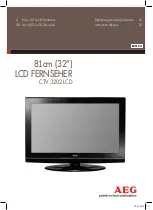
Service Modes, Error Codes, and Fault Finding
5.
back to
•
Via the blinking LED procedure (when you have no
picture). See paragraph
5.7 The Blinking LED Procedure
•
Via ComPair.
5.6.3
Error codes
Take notice that some errors need several minutes before they
start blinking or before they will be logged. So in case of
problems wait 2 minutes from start-up onwards, and then
check if the front LED is blinking or if an error is logged.
In this chassis only “layer 2” error codes are available and point
to problems on the SSB. They are triggered by LED blinking
when CSM is activated. Only the following layer 2 errors are
defined:
Table 5-4 Error code overview
5.6.4
How to Clear the Error Buffer
The error code buffer is cleared in the following cases:
•
By using the CLEAR command in the SAM menu
•
By using the CLEAR command in the Factory mode:
•
If the content of the error buffer have not changed for 50
hours, the error buffer resets automatically.
Note: If you exit SAM by disconnecting the mains from the
television set, the error buffer is not reset.
5.7
The Blinking LED Procedure
5.7.1
Introduction
The software is capable of identifying different kinds of errors.
Because it is possible that more than one error can occur over
time, an error buffer is available, which is capable of storing the
last five errors that occurred. This is useful if the OSD is not
working properly.
Errors can also be displayed by the blinking LED procedure.
The method is to repeatedly let the front LED pulse with as
many pulses as the error code number, followed by a period of
1.5 seconds in which the LED is “off”. Then this sequence is
repeated.
Example (1): error code 4 will result in four times the sequence
LED “on” for 0.25 seconds / LED “off” for 0.25 seconds. After
this sequence, the LED will be “off” for 1.5 seconds. Any RC
command terminates the sequence. Error code LED blinking is
in red color.
Example (2): the content of the error buffer is “12 9 6 0 0” After
entering SDM, the following occurs.
•
1 long blink of 5 seconds to start the sequence.
•
12 short blinks followed by a pause of 1.5 seconds.
•
9 short blinks followed by a pause of 1.5 seconds.
•
6 short blinks followed by a pause of 1.5 seconds.
•
1 long blink of 1.5 seconds to finish the sequence.
•
The sequence starts again with 12 short blinks.
Description
Layer 1
Layer 2
Monitored
by
Error/
Prot
Error Buffer/
Blinking LED
Device
Defective Board
FE-bus
2
11
SOC
E
BL / EB
SSB
SSB
BE -bus
2
13
SOC
E
BL / EB
SSB
SSB
SRF-bus
2
14
SOC
E
BL / EB
SSB
SSB
12V
3
16
Stby µP/SOC
P
BL
/
Supply
Display supply
3
17
SOC
E
BL
/
Supply
HDMI mux
2
23
SOC
E
EB
SiI9287/9573
SSB
I2C switch
2
24/25
SOC
E
EB
PCA954X
SSB
Channel decoder 1
2
27
SOC
E
EB
CXD2834
SSB
Channel decoder 2
2
28
SOC
E
EB
CXD2834
SSB
Rogue HDCP2.2
2
29
SOC
E
EB
SiI9679
SSB
Lnb controller Single/dual
2
31
SOC
E
EB
LNBH25/26
SSB
Hybrid Tuner
2
34
SOC
E
EB
SUT-PEZ
SSB
Class-D
2
37
SOC
E
EB
/
SSB
Light sensor
6
43
SOC
E
EB
/
Set
RF4CE
6
46
SOC
E
EB
CC2533
Set
NT72314
9
61
SOC
E
BL
NT72314
SSB
Splash error
2
65
SOC
P
BL
NT314-SOC
SSB
















































